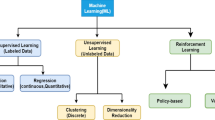Abstract
In the last decade, exponential growth of Internet of Things (IoT) and cloud computing takes the healthcare services to the next level. At the same time, lung cancer is identified as a dangerous disease which increases the global mortality rate annually. Presently, support vector machine (SVM) is the effective image classification tool especially in medical imaging. Feature selection and parameter optimization are the effective ways to improve the results of SVM and are conventionally resolved individually. This paper presents an optimal SVM for lung image classification where the parameters of SVM are optimized and feature selection takes place by modified grey wolf optimization algorithm combined with genetic algorithm (GWO-GA). The experimentation part takes place on three dimensions: test for parameter optimization, feature selection, and optimal SVM. For assessing the performance of the presented approach, a benchmark image database is employed which comprises of 50 low-dosage and stored lung CT images. The presented method exhibits its superior results on all the applied test images under several aspects. In addition, it achieves average classification accuracy of 93.54 which is significantly higher than the compared methods.




Similar content being viewed by others
References
Wang G, Ma J (2012) A hybrid ensemble approach for enterprise credit risk assessment based on support vector machine. Expert Syst Appl 39:5325–5331
B.E. Boser, I.M. Guyon, V.N. Vapnik, A training algorithm for optimal margin classifiers, in: Proceedings of the fifth annual workshop on Computational learning theory, pp. 144–152
Wu CH, Tzeng GH, Goo YJ, Fang WC (2007) A real-valued 1040 genetic algorithm to optimize the parameters of support vector machine for predicting bankruptcy. Expert Syst Appl 32:397–408
Zhai S, Jiang T (2014) A novel particle swarm optimization trained support vector machine for automatic sense-through-foliage target recognition system. Knowl-Based Syst 65:50–59
Cheng MY, Hoang ND, Wu YW (2013) Hybrid intelligence approach based on LS-SVM and differential evolution for construction cost index estimation: a Taiwan case study. Autom Constr 35:306–313
Cheng L, Bao W (2014) Remote sensing image classification based on optimized support vector machine. Indonesian Journal of Electrical Engineering and Computer Science 12:1037–1045
Z. Li, J. Liu, J. Tang, H. Lu, Robust structured subspace learning for data representation, IEEE transactions on pattern analysis 965 and machine intelligence 37 (2015) 2085–2098
Tang J, Li Z, Wang M, Zhao R (2015) Neighborhood discriminant 1030 hashing for large-scale image retrieval. IEEE Trans Image Process 24:2827–2840
Maldonado S, Carrizosa E, Weber R (2015) Kernel penalized Kmeans: a feature selection method based on kernel K-means. Inf Sci 322:150–160
Abdi MJ, Giveki D (2013) Automatic detection of erythematosquamous diseases using PSO-SVM based on association rules. Eng Appl Artif Intell 26:603–608
Pedergnana M, Marpu PR, Dalla Mura M, Benediktsson JA, Bruzzone L (2013) A novel technique for optimal feature selection in attribute profiles based on genetic algorithms. IEEE Trans Geosci Remote Sens 51:3514–3528
Yu N, Yang H (2007) An improved multi-class support vector machine for hyperspectral remote sensing imagery classification. Remote Sensing Information 5:7–11
Huang CL, Wang CJ (2006) A GA-based feature selection and parameters optimization for support vector machines. Expert Syst Appl 31:231–240
Lin SW, Ying KC, Chen SC, Lee ZJ (2008) Particle swarm optimization for parameter determination and feature selection of support vector machines. Expert Syst Appl 35:1817–1824
Bazi Y, Melgani F (2006) Toward an optimal SVM classification 900 system for hyperspectral remote sensing images. IEEE Trans Geosci Remote Sens 44:3374–3385
S. Ding, L. Chen, Classification of hyperspectral remote sensing 925 images with support vector machines and particle swarm optimization, in: 2009 International Conference on Information Engineering and Computer Science, pp. 1–5
Wang Y, Liu H, Zheng W, Xia Y, Li Y, Chen P, Guo K, Xie H (2019) Multi-objective workflow scheduling with deep-Q-network-based multi-agent reinforcement learning. IEEE Access 7:39974–39982
Wu W, Pirbhulal S, Zhang H, Mukhopadhyay SC (2019) Quantitative assessment for self-tracking of acute stress based on triangulation principle in a wearable sensor system. IEEE journal of biomedical and health informatics 23(2):703–713
Han J, Ji X, Hu X, Zhu D, Li K, Jiang X, Cui G, Guo L, Liu T (2013) Representing and retrieving video shots in human-centric brain imaging space. IEEE Trans Image Process 22(7):2723–2736
Zhang D, Meng D, Han J (2016) Co-saliency detection via a self-paced multiple-instance learning framework. IEEE Trans Pattern Anal Mach Intell 39(5):865–878
Han J, Zhang D, Cheng G, Guo L, Ren J (2014) Object detection in optical remote sensing images based on weakly supervised learning and high-level feature learning. IEEE Trans Geosci Remote Sens 53(6):3325–3337
Srinivas M, Patnaik LM (1994) Genetic algorithms: a survey. Computer 27:17–26
Scholkopf B, Smola AJ (2002) Learning with kernels: support vector ¨ machines, regularization, optimization, and beyond. MIT press
Yin S, Yin J (2016) Tuning kernel parameters for SVM based on expected square distance ratio. Inf Sci 370-371:92–102
Lakshmanaprabu SK, Shankar K, Ilayaraja M, Nasir AW, Vijayakumar V, Chilamkurti N (2019) Random forest for big data classification in the internet of things using optimal features. International journal of machine learning and cybernetics, 1-10. https://doi.org/10.1007/s13042-018-00916-z
Shankar, K., Lakshmanaprabu, S. K., Gupta, D., Maseleno, A., & de Albuquerque, V. H. C. (2018). Optimal feature-based multi-kernel SVM approach for thyroid disease classification. The journal of supercomputing, 1-16
Lakshmanaprabu SK, Shankar K, Khanna A, Gupta D, Rodrigues JJ, Pinheiro PR, De Albuquerque VHC (2018) Effective features to classify big data using social internet of things. IEEE Access 6:24196–24204
Lakshmanaprabu SK, Mohanty SN, Shankar K, Arunkumar N, Ramirez G (2019) Optimal deep learning model for classification of lung cancer on CT images. Futur Gener Comput Syst 92:374–382
Author information
Authors and Affiliations
Corresponding author
Ethics declarations
Conflict of interest
The authors declare no conflict of interest.
Additional information
Publisher’s note
Springer Nature remains neutral with regard to jurisdictional claims in published maps and institutional affiliations.
Rights and permissions
About this article
Cite this article
Valluru, D., Jeya, I.J.S. IoT with cloud based lung cancer diagnosis model using optimal support vector machine. Health Care Manag Sci 23, 670–679 (2020). https://doi.org/10.1007/s10729-019-09489-x
Received:
Accepted:
Published:
Issue Date:
DOI: https://doi.org/10.1007/s10729-019-09489-x




